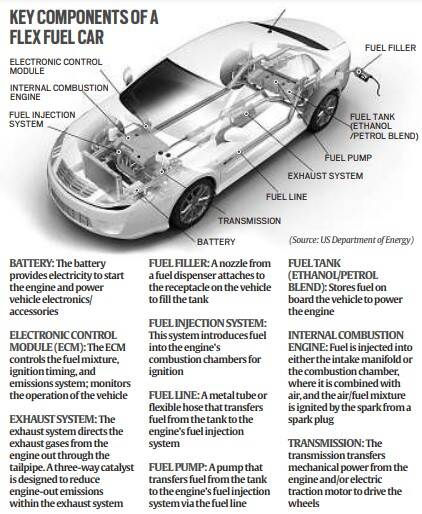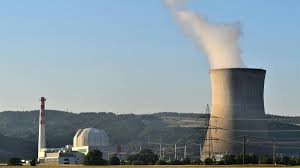- Courses
- GS Full Course 1 Year
- GS Full Course 2 Year
- GS Full Course 3 Year
- GS Full Course Till Selection
- Answer Alpha: Mains 2025 Mentorship
- MEP (Mains Enrichment Programme) Data, Facts
- Essay Target – 150+ Marks
- Online Program
- GS Recorded Course
- Polity
- Geography
- Economy
- Ancient, Medieval and Art & Culture AMAC
- Modern India, Post Independence & World History
- Environment
- Governance
- Science & Technology
- International Relations and Internal Security
- Disaster Management
- Ethics
- NCERT Current Affairs
- Indian Society and Social Issue
- NCERT- Science and Technology
- NCERT - Geography
- NCERT - Ancient History
- NCERT- World History
- NCERT Modern History
- CSAT
- 5 LAYERED ARJUNA Mentorship
- Public Administration Optional
- ABOUT US
- OUR TOPPERS
- TEST SERIES
- FREE STUDY MATERIAL
- VIDEOS
- CONTACT US
Electrified Flex Fuel Vehicle (FFV)
Electrified Flex Fuel Vehicle (FFV)
30-08-2023
-1693633338162.png)
Latest Context:
Recently, World’s first prototype of the BS 6 stage II ‘Electrified Flex Fuel Vehicle’ was launched.
More about the news:
- This FFV has both the flex fuel engine as well as an electric powertrain.
- This provides higher use of ethanol, combined with higher fuel efficiencies.
- Basically, an FFV has an internal combustion engine that can run on more than one type of fuel, or even a mixture of fuels such as petrol and ethanol. For example: E85 which has 85% ethanol fuel and 15% gasoline or other hydrocarbon by volume.

Benefits of Flex Fuel Vehicles (FFVs)
- Fuel Flexibility: FFVs can run on a range of fuels, including gasoline or any blend in between. This flexibility can be advantageous when different fuels are available or when there are variations in fuel prices.
- Reduced Greenhouse Gas Emissions: Ethanol, particularly when derived from renewable sources like corn or sugarcane, can produce fewer greenhouse gas emissions compared to traditional gasoline. Using E85 in an FFV can help reduce the carbon footprint of the vehicle.
- Support for Renewable Energy: The production of ethanol often relies on renewable resources, which can contribute to energy security and reduce reliance on fossil fuels.
- Potential Cost Savings: E85 is often cheaper than gasoline, which can result in cost savings for FFV owners, especially if E85 prices are significantly lower than gasoline prices.
- Government Incentives: In some regions, there may be government incentives or tax benefits for owning and operating FFVs due to their lower environmental impact.
- Reduced Dependence on Imported Oil: Ethanol is typically produced domestically, which can reduce a country's dependence on imported oil and enhance energy security.
- Support for Agriculture: Ethanol production often involves crops like corn, which can benefit agricultural communities by creating demand for their products.
- Hybrid Options: Some FFVs are available with hybrid technology, combining electric motors with the internal combustion engine.
- Environmental Benefits: While the environmental benefits of FFVs depend on factors like the source of ethanol and the energy efficiency of the vehicle, they have the potential to reduce overall emissions and air pollution.
Drawbacks are:
- Lower Fuel Efficiency: When running on E85 (85% ethanol and 15% gasoline), FFVs often experience lower fuel efficiency compared to when running on gasoline. This means you may need to refuel more frequently, which can offset the cost savings from cheaper E85.
- Reduced Driving Range: Due to lower fuel efficiency on E85, FFVs typically have a reduced driving range on a full tank compared to when using gasoline.
- Limited E85 Availability: E85 fuelling stations are not as widespread as gasoline stations in many areas. This can make it challenging to find E85, particularly in rural or less populated regions, limiting the convenience of FFVs.
- Potential Engine Performance Issues: Some FFVs may experience engine performance issues when running on E85, such as reduced power output or cold-weather starting difficulties. This can depend on the vehicle's design and the quality of the ethanol used.
- Emissions Variability: The environmental benefits of FFVs can vary depending on the source of the ethanol and the energy efficiency of the vehicle. Some ethanol production methods may not be as environmentally friendly as others, which can affect the overall carbon footprint.
- Higher Ethanol Content: In some regions, E85 might have a higher ethanol content, which can be less compatible with older vehicles and small engines (e.g., lawnmowers, boats) that are not designed to handle high ethanol blends. This can lead to engine damage or poor performance.
- Limited Vehicle Models: The selection of FFVs can be limited compared to traditional gasoline or hybrid vehicles. This can make it challenging to find an FFV that suits your preferences and needs.
Conclusion:
In summary, while Flex Fuel Vehicles offer the advantages of fuel flexibility and potentially lower greenhouse gas emissions, they also come with trade-offs, including reduced fuel efficiency, limited E85 availability, and potential engine performance issues. It's important to carefully evaluate your specific needs and circumstances before choosing an FFV and consider the availability of alternative technologies, such as hybrid or electric vehicles, which may offer different benefits and drawbacks.



